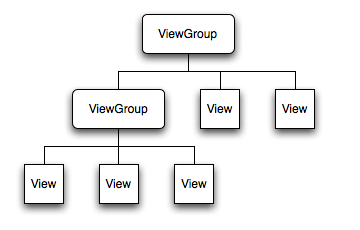回想你第一次看到Android设备时,上面各种酷炫的应用和游戏是不是让多年使用塞班手机的你感到amazing?能看到这篇文章说明你现在的工作多少和android开发相关。或许你是跟着教程写了一个HelloWold运行在模拟器或者真机上,结果出来的瞬间会有些自豪。心想着自己也是会android应用开发的人了。
接着可能陆陆续续的写了几个小Demo,这时候对android应用的印象多了四大组件等一些概念,提到view,你可能会说,视图不就是窗口,而一个窗口往往就是一个activity。所以会有一个activity就是一个view的错觉。其实也不能说完全错了,这其中确实有玄机。
为啥会让我们有activity即view的印象,原因就在于Activity一般都在onCreate函数中里使用setContentView设置UI界面。我们略作分析:
Activity.java
/**
* 根据布局文件来填充activity的view。
*/
public void setContentView(int layoutResID) {
getWindow().setContentView(layoutResID);//我们需要看下getWindow()返回的是什么。
}
/**
* Retrieve the current {@link android.view.Window} for the activity.
* This can be used to directly access parts of the Window API that
* are not available through Activity/Screen.
*
* @return Window The current window, or null if the activity is not
* visual.
*/
public Window getWindow() {
return mWindow;// 是window的一个实例
}
mWindow是何方神圣,又是谁创造了它,我们control+F一下在attach函数中找到了它mWindow =PolicyManager.makeNewWindow(this),不过又多出来一个PolicyManager,这货又是干啥的,我们进去看看先。
public final class PolicyManager {
private static final String POLICY_IMPL_CLASS_NAME =
"com.android.internal.policy.impl.Policy";
private static final IPolicy sPolicy;
static {
// Pull in the actual implementation of the policy at run-time
try {
Class policyClass = Class.forName(POLICY_IMPL_CLASS_NAME);
sPolicy = (IPolicy)policyClass.newInstance();
} catch (ClassNotFoundException ex) {
throw new RuntimeException(
POLICY_IMPL_CLASS_NAME + " could not be loaded", ex);
。。。。。。
// The static methods to spawn new policy-specific objects
public static Window makeNewWindow(Context context) {
return sPolicy.makeNewWindow(context);
}
}
该类代码比较少,申明了一个Policy类型的单例对象,我们再看看它是神马。
public PhoneWindow makeNewWindow(Context context) {
return new PhoneWindow(context);//亲,注意啦,出现关键词PhoneWindow。
}
到这里我们弄清楚了一个事实,mWindow就是一个PhoneWindow对象。同样的手法,我们可以知道mWindowManager成员变量的真实类型是LocalWindowManager。
弄清楚了以上概念,我们可以重新回到setContenView函数了。根据上面的结论,直接到PhoneWindow去找它。
public void setContentView(View view, ViewGroup.LayoutParams params) {
if (mContentParent == null) {
installDecor();
} else {
mContentParent.removeAllViews();
}
mContentParent.addView(view, params);
final Callback cb = getCallback();
if (cb != null) {
cb.onContentChanged();
}
}
可以知道mContentParent是viewGroup类型,它存在时就负责把view加载出来,不存在的时候会走installDecor方法。
private void installDecor() {
if (mDecor == null) {
mDecor = generateDecor();//创建mDecor,它是DecorView类型,继承于FrameLayout。
mDecor.setDescendantFocusability(ViewGroup.FOCUS_AFTER_DESCENDANTS);
mDecor.setIsRootNamespace(true);
}
if (mContentParent == null) {
mContentParent = generateLayout(mDecor);
//创建标题栏
mTitleView = (TextView)findViewById(com.android.internal.R.id.title);
......
}
}
这里需要我们进一步看下generateDecor()方法:
protected ViewGroup generateLayout(DecorView decor) {
// Apply data from current theme.
//1,根据getWindowStyle()返回的数组来设定一些窗口属性值feature,如是否全屏,是否带标题栏。
TypedArray a = getWindowStyle();
mIsFloating = a.getBoolean(com.android.internal.R.styleable.Window_windowIsFloating, false);
int flagsToUpdate = (FLAG_LAYOUT_IN_SCREEN|FLAG_LAYOUT_INSET_DECOR)
& (~getForcedWindowFlags());
if (mIsFloating) {
setLayout(WRAP_CONTENT, WRAP_CONTENT);
setFlags(0, flagsToUpdate);
} else {
setFlags(FLAG_LAYOUT_IN_SCREEN|FLAG_LAYOUT_INSET_DECOR, flagsToUpdate);
}
if (a.getBoolean(com.android.internal.R.styleable.Window_windowNoTitle, false)) {
requestFeature(FEATURE_NO_TITLE);
}
if (a.getBoolean(com.android.internal.R.styleable.Window_windowFullscreen, false)) {
setFlags(FLAG_FULLSCREEN, FLAG_FULLSCREEN&(~getForcedWindowFlags()));
}
if (a.getBoolean(com.android.internal.R.styleable.Window_windowShowWallpaper, false)) {
setFlags(FLAG_SHOW_WALLPAPER, FLAG_SHOW_WALLPAPER&(~getForcedWindowFlags()));
}
......
// Inflate the window decor.
//2,根据上面设定的features值,决定加载何种窗口布局文件。
int layoutResource;
int features = getLocalFeatures();
// System.out.println("Features: 0x" + Integer.toHexString(features));
if ((features & ((1 << FEATURE_LEFT_ICON) | (1 << FEATURE_RIGHT_ICON))) != 0) {
if (mIsFloating) {
layoutResource = com.android.internal.R.layout.dialog_title_icons;
} else {
layoutResource = com.android.internal.R.layout.screen_title_icons;
}
......
}
mDecor.startChanging();
//3,把特定的view添加到decorView里。
View in = mLayoutInflater.inflate(layoutResource, null);
decor.addView(in, new ViewGroup.LayoutParams(MATCH_PARENT, MATCH_PARENT));
//4,这个contentParent由findViewById返回,实际上就是mDecorView一部分。
ViewGroup contentParent = (ViewGroup)findViewById(ID_ANDROID_CONTENT);
......
mDecor.finishChanging();
return contentParent;
}
上面第二步提到根据上面设定的features值,决定加载何种窗口布局文件,我们找一个系统窗口布局文件分析一下:
路径在:.frameworks/base/core/res/layout/screen_title.xml
<!--
This is an optimized layout for a screen, with the minimum set of features
enabled.
-->
<LinearLayout xmlns:android="http://schemas.android.com/apk/res/android"
android:orientation="vertical"
android:fitsSystemWindows="true">
<FrameLayout
android:layout_width="match_parent"
android:layout_height="?android:attr/windowTitleSize"
style="?android:attr/windowTitleBackgroundStyle">
<TextView android:id="@android:id/title"
style="?android:attr/windowTitleStyle"
android:background="@null"
android:fadingEdge="horizontal"
android:gravity="center_vertical"
android:layout_width="match_parent"
android:layout_height="match_parent" />
</FrameLayout>
<FrameLayout android:id="@android:id/content"
android:layout_width="match_parent"
android:layout_height="0dip"
android:layout_weight="1"
android:foregroundGravity="fill_horizontal|top"
android:foreground="?android:attr/windowContentOverlay" />
</LinearLayout>
可以看到是一个简单的布局文件,一个LinearLayout下包含了两个子FrameLayout视图,第一个FrameLayout用来显示标题栏(TitleBar);第二个FrameLayout用来显示id为content视图。

以上我们由setcontentView()引出了两个在view界举足轻重的大佬PhoneWindow和DecorView,它们之间的关系可以简单用下面的图来表示。

举个不太恰当的类比:如果说PhoneWindow是画,一种抽象概念的画,那DecorView会更具体一点,它可以是山水画。而MyView就是具体的唐伯虎手下的凤凰傲意图了。
这里说的View、DecorView等都是UI单元,这些UI单元工作都在onDraw函数中完成。如果把onDraw想象成画图过程,那我们需要知道画布是什么?查阅资料后,得出答案就是Surface,关于它的前世今生还需看一下源码ViewRoot.java。
public final class ViewRoot extends Handler implements ViewParent,
View.AttachInfo.Callbacks {
View mView;
private final Surface mSurface = new Surface();
}
以上我们收集齐了PhoneWindow,DecorView,ViewRoot,Surface四颗神奇的龙珠,让我们一起把view召唤到手机屏幕上吧。
以上只是些开胃菜,需果腹,请看戏说Android
view 工作流程《下》。
分享到:











相关推荐
第一章面试受挫——代码无错就是好? 第二章代码规范、重构 第三章复制 VS复用 第四章业务的封装 第五章体会简单工厂模式的美妙 第六章工厂不好用了?...第十三章设计模式不能戏说!设计模式怎就不能戏说?
大班音乐:戏说脸谱.ppt
戏说指针 如何分析指针类型 细说指针 指针的类型 指针所指向的类型 指针的值 指针本身所占据的内存区
C# 面向对象设计 让你了解C#的面向对象的设计原理 更好的掌握C#的学习 真正的成为C#高手
一本很不错的讲面向对象的书,给大家分享下 !
指针的本质、指针的三要素、类型与变量名
幼儿园大班歌唱教案:戏说脸谱.doc
简单明了的解释 很实用
1.使用轻松的方式解释23种设计模式,很容易理解
戏说国学.doc
戏说面向对象程序设计(C#版)面向对象程序设计(C#版)
戏说绩效工资.doc
幼儿园教案2021-幼儿园大班歌唱教案:戏说脸谱.doc
戏说信号与系统,大家可以参考一下,很浅显易懂
戏说TCP网络编程.doc
戏说绩效工资精选.doc
戏说地沟油学习教案.pptx
戏说国内三大博客.docx